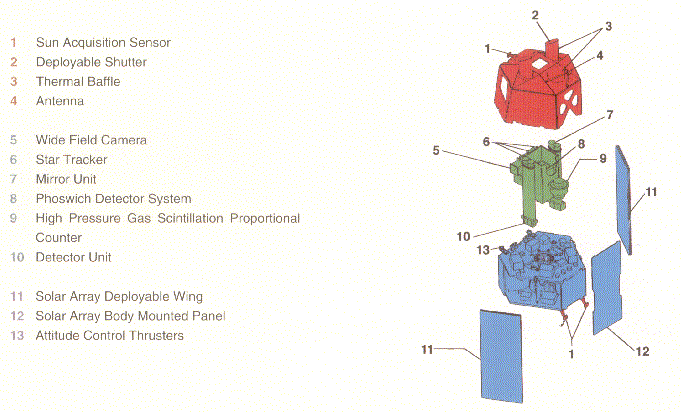
If your browser does not support tables (or anchors in table cells), please use the pre-formatted tables.
You can click on the numbers on the exploded view of the satellite (or the text at its left) to go directly to the description of the subsystem.

| Payload | |
|---|---|
| Science Instrument | Task |
| Low Energy Concentrator Spectrometer (LECS) | X-ray spectrometry/imaging in the 0.1-10 keV energy range |
| Medium Energy Concentrator Spectrometer (MECS) | X-ray spectrometry/imaging in the 1-10 keV energy range |
| High Pressure Gas Scintillation Proportional Counter (HP-GSPC) | X-ray spectrometry in the 3-120 keV energy range |
| Phoswich Detector System (PDS) | X-ray spectrometry in the 15-300 keV energy range and Gamma-ray burst monitoring in the 60-600 keV energy range |
| Wide Field Cameras (WFCs) | X-ray spectrometry/imaging in the 2-30 keV energy range |
| Spacecraft | |
|---|---|
| Subsystem | Task |
| Structure (STS) | Holding all spacecraft subsystems and science instruments |
| Thermal Control (TCS) | Ensuring temperature ranges and gradients during all mission phases |
| Harness (HRNS) | Electrical interconnection |
| On Board Data Handling (OBDH) | On board data storage and communication management |
| Telemetry Tracking & Commands (TT&C) | Commanding and telemetry data transmission through RF link |
| Attitude and Orbit Control (AOCS) | Satellite attitude determination and pointing to the selected sources |
| Reaction Control (RCS) | Thrusting capability for orbit recovery |
| Electrical Power (EPS) | Energy storage, voltage regulation, power switching and distribution |
| Solar Array (SAS) | Power supply during sunlight phase |
| Electrical Ground Support Equipment (EGSE) | H/W and S/W to support integration and testing |